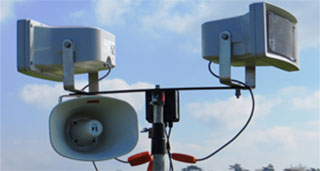Basic Types of Lantern
Stage lanterns or lights are now officially known as luminaires. The ten basic types listed and described here are those in most common use. Many variations are constantly coming on to the market, but, they all fulfil the basic purpose of either a soft edged spot, a hard edged spot or a wash (flood) light. Moving lights quite often combine two or more of these functions in one unit. Also, an increasing number now use LEDs as their light source instead of a tungsten-halogen lamp.
Fresnel Spot:
A soft-edged light adjustable from a tight spot to a large pool. Very useful for short throws such as on-stage work. This type of luminaire (lantern) can be fitted with barn doors to give a coarse beam shaping ability, however some designs do have the disadvantage of stray spill light due to reflections from the ‘stepped’ lens.
Plano-Convex Spot:
Most often referred to as a ‘focus spot’ these use a plano-convex (PC) lens to collect and concentrate the light into a tight, yet adjustable, beam. This type of luminaire (lantern) has now been largely superseded by the Pebble Spot.
Pebble Spot:
A variation on the original focus spot this luminaire is similar except that the plano-convex lens has a ‘pebbled’ back face. This improves the beam quality by giving it a smoother, softer edge. The beam size of a pebble spot is adjustable to almost the same extent as a Fresnel and, like a Fresnel it can be fitted with barn doors for beam shaping.
Profile Spot:
In its basic form these lanterns produce a fixed size, hard edged beam, although this can be softened by throwing it out of focus. They have a ‘gate slot’ into which can be inserted beam shaping shutters, an iris or a gobo pattern for projection. In general these luminaires are most often used in front-of-house positions where their longer throw and accurately controlled beam are essential. A development of the basic profile spot is the ‘zoom spot’. This has two independently adjustable lenses which allow the cone of light produced to be zoomed from a small to a large diameter.
Followspot:
A followspot is a specialised, narrow beam profile spot with improved optics and additions such as handles to allow steering, an accurate iris including a black-out disc and a built in colour-changer. The major use for these luminaires is to highlight and follow performers in cabaret, concerts and musicals. They are usually situated towards the rear of the auditorium area, although they are also used from behind the performer to act as moving backlight. Each followspot normally requires its own operator but intelligent lights can be programmed to fulfil a similar role.
Floodlight:
Basically a simple lamp-in-a-box with a reflector designed to put the maximum amount of light over the maximum area. These lights have no lenses and beam control is achieved with a variety of barn door type attachments. More modern versions of the ‘floodlight’ have become popularly known as washlights.
Cyc Light:
An asymmetrical floodlight i.e. the lamp is not in the middle of the reflector. This gives more light in one direction than the other. The main use of these fittings is for lighting at the top or bottom of a cyclorama or cloth where its design gives a more even spread of light over the whole area.
Parcan:
A parcan has no optical system of its own this is entirely contained within the sealed-beam lamp which looks rather like an old type of car headlamp. However, the PAR lamp optics are very efficient producing an intense beam of almost parallel light which is usually oval in shape. The lamps are available in very narrow, narrow, medium and flood beam angles. The only other beam control is either by rotating the lamp or by using barn doors. This luminaire is most often used for lighting pop music concerts and fashion shows although in drama it does make a very effective substitute for sunlight through a window.
Pinspot:
These small luminaires usually come with a built-in transformer to supply their low-voltage lamp. They produce a bright, narrow beam of light and are easily concealed within a set for highlighting specific areas. They are also used to light mirrorballs and for other disco effects. Motorised versions of them were popular as disco lighting in the 1970s. They were known variously as ‘scanners’, ‘helicopters’, ‘light harvesters’ etc.
Birdie Cans:
Looking like miniature parcans, but using a low voltage MR16 dichroic lamp, these extremely useful luminaires are used in much the same way as a pinspot for highlighting and special effects within a set. Incidentally the nickname comes from golf where a ‘birdie’ is one shot under par.

